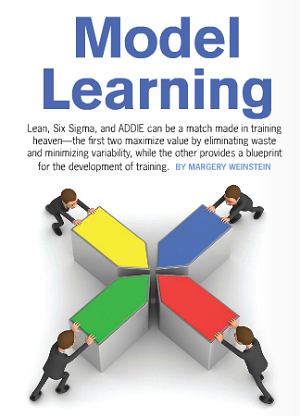Posted by Caveo Learning ● May 14, 2015
Learning Leaders Introducing ADDIE to Fellow Models Lean, Six Sigma
 The ADDIE Model—Analyze, Design, Develop, Implement, Evaluate—is synonymous with learning and development as the industry's model of choice. But as learning departments move to become more closely aligned with the larger business, two other recognizable business models, Lean and Six Sigma, are increasingly finding their way into the L&D world.
The ADDIE Model—Analyze, Design, Develop, Implement, Evaluate—is synonymous with learning and development as the industry's model of choice. But as learning departments move to become more closely aligned with the larger business, two other recognizable business models, Lean and Six Sigma, are increasingly finding their way into the L&D world.
While Lean and Six Sigma are frequently deployed together, it remains somewhat novel to combine them with ADDIE. Nevertheless, just as learning leaders can better illustrate L&D's business value by speaking in business-focused metrics, rather than learning-centric qualifiers, the learning function is likewise well served by aiming to minimize waste and reduce defects within the learning solutions lifecycle.
In the May 2015 issue of Training magazine, Margery Weinstein examines how Caveo Learning has helped retail chain Wawa to improve its corporate training processes by merging ADDIE with Lean and Six Sigma.
To benefit from the three combined models, organizations first must define the problems to be solved, along with the various related processes. These challenges can include inefficient resource deployment, insufficient metrics, or subpar training deliverables. Joseph Tota, a strategic learning partner with Caveo, recommends that L&D organizations define processes, roles, and standard operating procedures from the initiation of a business need, from business partner to the maintenance of content after implementation.
Stefanie Sharpless, manager of Wawa's corporate education wing, Wawa University, tells Training that her organization's entire learning and development process has become simplified thanks to the Lean-Six Sigma-ADDIE triumverate, enabling Wawa University to provide employees with clearer role expectations and enhanced performance accountability. “Our learners get the benefits of consistently developed curriculum that is cohesively designed, instead of curriculum that feels like many business partners and designers independently developed it," Sharpless says. "This allows our in-store trainers to more easily oversee the associate’s learning experience and our associates to have a standard learning model to follow.”
The result has been improved time to proficiency and staff retention, she says. Even better, the process allows Wawa associates to get more efficient with every project, because every project serves as a learning opportunity to enhance the way they work for future projects.
6 Conditions to Define During Lean-Six Sigma-ADDIE Process
Caveo recommends that the following six conditions be defined in order to maximize the impact of the combined Lean-Six Sigma-ADDIE process:
1. Role: Clarify who does what in the process
2. Process: A documented process must be established and followed by all roles
3. Metrics: Measurable points in the process must be reported in order to build efficiencies
4. Expectations: Standards and time horizons must be set with key roles to ensure throughput
5. Quality: Checks on quality must be applied throughout the process
6. Approvals: Stakeholder approvals will minimize unnecessary rework
“We find the first step of rigorously documenting roles and processes and changing behaviors to follow is typically the hardest part," Joe Tota tells Training. "Organizations that are most successful have leaders that sponsor and champion process improvement efforts."
Click here to read more about the advantages of and challenges to merging ADDIE with Lean and Six Sigma.
Topics: Learning Strategy
